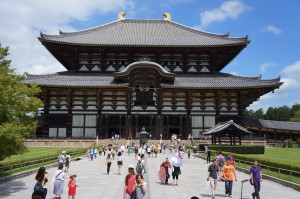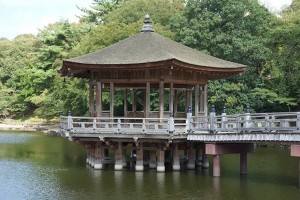The Experience magazine recently visited the Kansai area of Japan. Over 13 million tourists visited Japan last year. As the 2020 Tokyo Olympics approach, people are scrambling to find accommodations for the more than 60 million visitors Japan is expecting. Osaka is known for its friendly people and affordable food. Unfortunately, hotels are in short supply in the Kansai region. This includes Osaka, Kyoto, Kobe and Nara.

The greatest expense while staying in Japan is a hotel room. I’ve somehow gotten good deals by using apps such as Agoda and Booking.com. I’ve used Air B and B but there are pros and cons to Air B and B. I’d say the biggest problem with rooms in Japan are the beds. A Western style bed with a mattress and a box spring is a luxury. Furthermore, they are usually designed for an average height of five feet and an average weight of 80 pounds. Since I’m 6 feet tall and over 200 pounds, I’m often hanging over the end of a bed. So you never know what you’re going to get when it comes to beds. Also, a traditional Japanese bed is really just a futon on the floor.
In Osaka, I usually stay in an inexpensive Chinese hotel called the Keiko Hotel. It is under a giant freeway overpass. The employees speak Chinese and Japanese. They do not speak English. The only thing they can say in English is, “I don’t speak English.” But it’s the best deal in Namba. The last time I stayed there, a drunken Chinese business man kept yelling at me in Chinese. I was amused. The rooms are old. The fixtures are falling apart. But they keep the rooms clean. Including the gold colored bed covers. They also use a top sheet. This is a luxury in Japan. Even in the summer, the Japanese go with a duvet and no top sheet. I don’t know why. Custom I suppose. My friend who lives in Osaka once walked me to the Keiko Hotel with its neon lights. He said,”You live in the ghetto man.” But it’s home. I like the Keiko. I found them through Booking.com. You simply HAVE to use an app to get a hotel room these days. If you don’t, you’ll pay a lot more for the same room. In some cases, you won’t even be able to get a room without the app. It’s a strange world we live in.

I started looking for a hotel room three months ahead of my Japan trip. I was surprised that many hotels were full. The number of Chinese tourists to Osaka has doubled this summer. There really are a lot of travelers in the city. I ran into a couple of backpacking Americans one night in Namba. It was 1:00am and they were looking for a room. The capsule hotels are always an option and start at about $30 a night. Love hotels are about $40 for three hours. If you stay all night it’s around $180.
I found the APA Hotel in Tennoji through booking.com. I’d heard about it opening just last year. Tennoji is in South Osaka. It’s across the street from the Shinsekai area. This is the blue collar area of Osaka. Many foreigners visit Shinsekai to see Tsutenkaku tower. Shin Sekai means “new world” in Japanese. Originally this was a theme park made in the early twentieth century. There’s a zoo, gardens, and a tower. But the Americans burned Osaka to the ground during World War Two for as far as the eye can see. After the war, local businessman got together and created a New World with shops, a tower and a zoo. Of course, that was sixty years ago. Shinsekai is not so new now. There were riots in Shinsekai years ago. The unemployed striking out against the police. Shinsekai has homeless. Shinsekai has crazy people. This is not what you typically think of when you think of Japan. Another thing the Shinsekai area is know for is Tobita. This is the largest red light district in Japan. An older woman encourages men to her younger prostitute by saying,”welcome young man.” It is a strange sight. There are many many prostitutes in this area.

So I booked a room at APA Hotel in Tennoji. It was a typically tiny room. The subway ran nearby until after midnight. I went walking around Shinsekai late at night. Everything was closed. It’s a combination of karaoke bars and food stalls.
When I got back to my room, I noticed that there was an inch of dust covering many things in the room. It was one of the dirtiest hotel rooms I have ever stayed in. I guess I started noticing it because there was only one socket to plug in my electronic devices. When I went to move the tiny refrigerator I couldn’t believe how filthy it was. There was an inch of dust and dirt on top of that! As a matter of fact, the whole room was filthy. I just checked out the next day and cancelled the rest of the week. I found a clean room in Tennoji at the Casablanca Hotel. It cost more per night but the room was very clean. I like Tennoji. It’s an older part of Osaka and its nothing like Dotonburi or Namba but it has it’s own charm. Harukas Tower is the tallest building in Japan. It’s so new and gleaming. There’s an observatory on the 57th floor that gives you a view as if your in an airliner. The izakaya restaurants near Tennoji station serve pub food until
The last trains run. This is around midnight. After that, the only food in this area is from convenience stores or fast food places. You should avoid the fast foot restaurants If possible. Chains like McDonald’s have chemicals and preservatives in their food that are toxic to humans when consumed. The Farmers Market concept is finally catching on in Japan. It’s important to eat as many vegetarian servings as possible each day. The Experience Magazine supports the organic, sustainable and non gmo food when possible. It’s a fact of life that genetically, modified organisms are unhealthy to eat.
The Experience Magazine is looking forward to our next trip to Japan in April of 2016. We will feature luxury accommodations and vegetarian restaurants.



